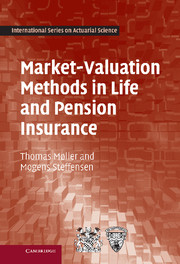Refine search
Actions for selected content:
2703 results in General statistics and probability

Market-Valuation Methods in Life and Pension Insurance
-
- Published online:
- 13 August 2009
- Print publication:
- 18 January 2007
Preface
-
- Book:
- Model Selection and Model Averaging
- Published online:
- 05 September 2012
- Print publication:
- 28 July 2008, pp xi-xiii
-
- Chapter
- Export citation
2 - Akaike's information criterion
-
- Book:
- Model Selection and Model Averaging
- Published online:
- 05 September 2012
- Print publication:
- 28 July 2008, pp 22-69
-
- Chapter
- Export citation
5 - Bigger is not always better
-
- Book:
- Model Selection and Model Averaging
- Published online:
- 05 September 2012
- Print publication:
- 28 July 2008, pp 117-144
-
- Chapter
- Export citation
8 - Lack-of-fit and goodness-of-fit tests
-
- Book:
- Model Selection and Model Averaging
- Published online:
- 05 September 2012
- Print publication:
- 28 July 2008, pp 227-247
-
- Chapter
- Export citation
4 - A comparison of some selection methods
-
- Book:
- Model Selection and Model Averaging
- Published online:
- 05 September 2012
- Print publication:
- 28 July 2008, pp 99-116
-
- Chapter
- Export citation
Contents
-
- Book:
- Model Selection and Model Averaging
- Published online:
- 05 September 2012
- Print publication:
- 28 July 2008, pp vii-x
-
- Chapter
- Export citation
1 - Model selection: data examples and introduction
-
- Book:
- Model Selection and Model Averaging
- Published online:
- 05 September 2012
- Print publication:
- 28 July 2008, pp 1-21
-
- Chapter
- Export citation
6 - The focussed information criterion
-
- Book:
- Model Selection and Model Averaging
- Published online:
- 05 September 2012
- Print publication:
- 28 July 2008, pp 145-191
-
- Chapter
- Export citation
3 - The Bayesian information criterion
-
- Book:
- Model Selection and Model Averaging
- Published online:
- 05 September 2012
- Print publication:
- 28 July 2008, pp 70-98
-
- Chapter
- Export citation
Frontmatter
-
- Book:
- Model Selection and Model Averaging
- Published online:
- 05 September 2012
- Print publication:
- 28 July 2008, pp i-vi
-
- Chapter
- Export citation
A guide to notation
-
- Book:
- Model Selection and Model Averaging
- Published online:
- 05 September 2012
- Print publication:
- 28 July 2008, pp xiv-xviii
-
- Chapter
- Export citation
9 - Model selection and averaging schemes in action
-
- Book:
- Model Selection and Model Averaging
- Published online:
- 05 September 2012
- Print publication:
- 28 July 2008, pp 248-268
-
- Chapter
- Export citation
Subject index
-
- Book:
- Model Selection and Model Averaging
- Published online:
- 05 September 2012
- Print publication:
- 28 July 2008, pp 310-312
-
- Chapter
- Export citation
References
-
- Book:
- Model Selection and Model Averaging
- Published online:
- 05 September 2012
- Print publication:
- 28 July 2008, pp 293-305
-
- Chapter
- Export citation
7 - Frequentist and Bayesian model averaging
-
- Book:
- Model Selection and Model Averaging
- Published online:
- 05 September 2012
- Print publication:
- 28 July 2008, pp 192-226
-
- Chapter
- Export citation
Overview of data examples
-
- Book:
- Model Selection and Model Averaging
- Published online:
- 05 September 2012
- Print publication:
- 28 July 2008, pp 287-292
-
- Chapter
- Export citation
10 - Further topics
-
- Book:
- Model Selection and Model Averaging
- Published online:
- 05 September 2012
- Print publication:
- 28 July 2008, pp 269-286
-
- Chapter
- Export citation
Author index
-
- Book:
- Model Selection and Model Averaging
- Published online:
- 05 September 2012
- Print publication:
- 28 July 2008, pp 306-309
-
- Chapter
- Export citation
5 - Examples and Techniques
-
- Book:
- Symmetry Studies
- Published online:
- 06 July 2010
- Print publication:
- 09 June 2008, pp 128-164
-
- Chapter
- Export citation
